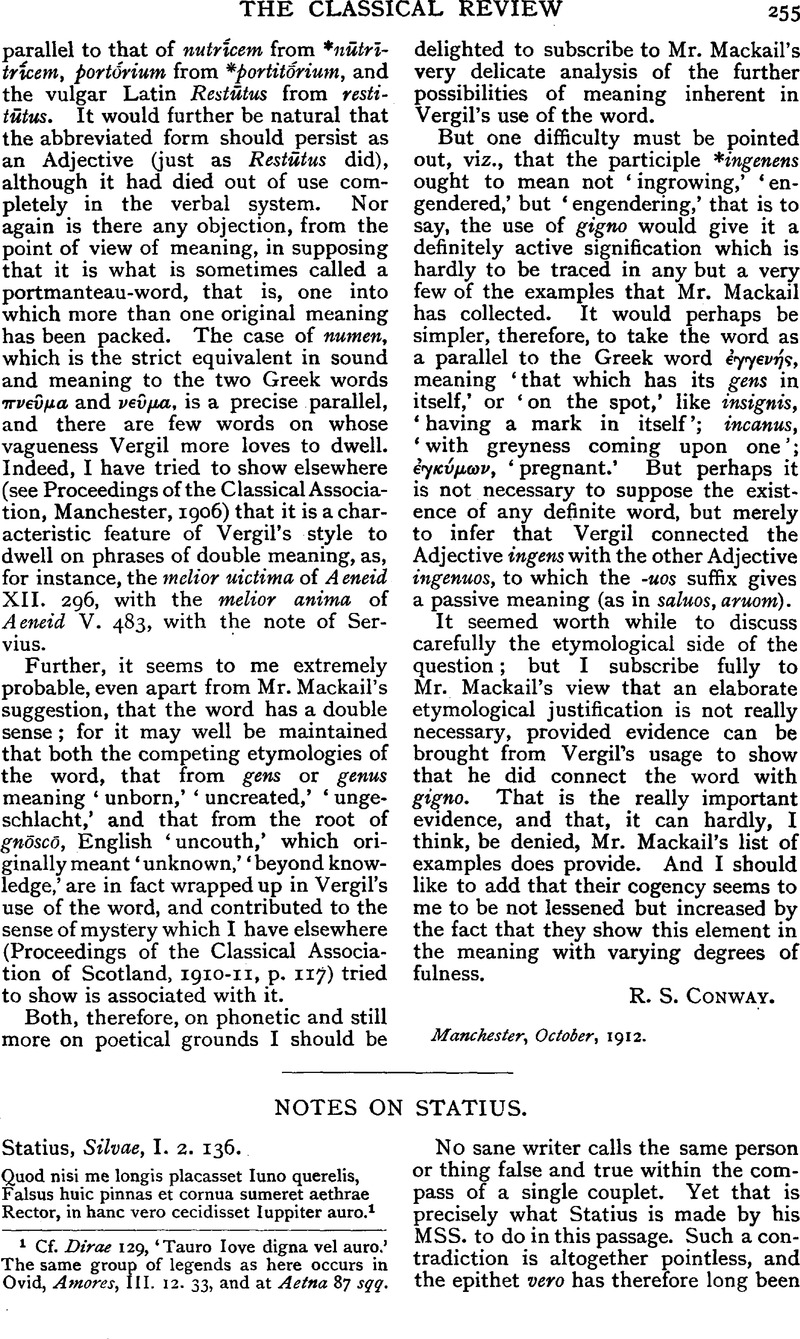No CrossRef data available.
Article contents
Abstract

- Type
- Original Contributions
- Information
- Copyright
- Copyright © The Classical Association 1912
References
page 255 note 1 Cf. Dirae 129, ‘Tauro love digna vel auro.’ The same group of legends as here occurs in Ovid, Amores, III. 12. 33, and at Aetna 87 sqq.
page 256 note 1 ‘“vero” soll m. E. andeuten, dass es sich bet Violentilla nicht, wie bei Danae, um eine blosse Fabel aus dem Bereiche der poetischen Fiktionen handeln würde’ (Dr.Ziehen, Julius, Wochenschrift für Klass. Phil., March 8, 1910).Google Scholar
page 256 note 2 See Dr. Macan's Herodotus, vol. ii., note ad fin., on the dance of Hippocleides.
page 256 note 3 ‘It seems to be true that the oldest Roman religion had no idols. It worshipped natural objects themselves — fountains, fire, stones (luppiter Lapis)’ (Seeley, , Livy, Book I., p. 41Google Scholar); but on Iuppiter Lapis see Dr.Reid, J. S. in the J.R.S. (1912), p. 511.Google Scholar
page 256 note 4 The early copies would resemble that of the poem on the Battle of Actium, a fragment of which (on papyrus), found at Herculaneum, is discussed by ProfessorEllis, in C.R. xxii. 125Google Scholar. But chronological considerations seem to forbid us to hope for any Statius from Herculaneum, even if the optimism of Dr. Waldstein is justified and the place is ‘excavated in our time.’ In this connexion it may be worth while to recall the statement of Barth, referred to by Markland in his preface. The extract (which I owe to the kindness of Mr. R. L. Poole) runs as follows: ‘Rari autem harum Silvarum Codices scripti. Notus Senensis, ab eodem Scaligero aliis communicatis Variis Lectionibus. Duos nos habuimus emtos, alterum capitalibus litieris scriptum, sed uti, nisi perpaucis horis, non licuit, et nunc perisse utrumque arbitror. Ad me sane reversus neuter est, cum tamen domesticis flammis elapsos suspicer…. Flammae autem non ab hoste, sed domestico paene scelere, meae turn mansioni iniectae, non hoc solum mihi damnum confecerunt, sed ingens scrinium, manu mea scriptis chartis effertum, simulabstulerunt’.—Publ. Papinii Statii quae exstant (Cygneae 1664) Barth, , ad Silv. Animadv., p. 9.Google Scholar
page 257 note 1 I owe the idea to Mr. Housman on II. 6.93. But his ‘restoration’ of that passage, ‘sed flesse iuvat,’ can hardly be regarded as final. Is it possible that there we should read rather ‘sed et ipse bibat’ (iuvat=vivat=bibat), with a play upon the normal use of the word in the phrase above, ‘Hos bibit usque rogus’?—‘But let the master too (‘et ipse’) drink and forget his trouble.’ Cf. ‘ Luce tuum defies mutata veste maritum, | Et deplorato coniuge nocte bibis,’ and for a modern parallel to the grim pleasantry, Mr. Wm. Watson's lines in The Great Misgiving:
Life is a feast, and we have banqueted,—Shall not the worms as well?
It is not improbable that a somewhat similar play on words underlies a well-known difficulty in Ovid, Metam. VI. 582. Philomela in captivity weaves upon the loom the story of her betrayal by Tereus:
Stamina barbarica suspendit callida tela Purpureasque notas filis intexuit albis, Indicium sceleris….
The web is sent to her sister Procne. Then in the MSS. the story proceeds thus:
Evolvit vestes saevi matrona tyranni,
Fortunaeque suae carmen miserabile legit. Heinsius and Housman would read ‘Germanaeque suae’—rather a violent alteration. For ‘carmen’ one MS. (‘unus codex Housman,’ Corpus, Not. crit.) has ‘fatum.’ Read ‘stamen,’ and compare Tristia, V. 13. 24, ‘Non ita sunt fati stamina nigra mei’; sense— ‘In a moment she gathered up the clue of her own fate.’ Cf., e.g., Propertius, IV. 4. 42, … patuit lecto stamine torta via. The ‘carmen miserabile’ of the MSS. represents a scribe's ill-timed recollection of Virgil's Philomel (G. IV. 514), ‘Flet noctem ramoque sedens miserabile carmen Integrat.’
page 257 note 2 See the transcript of the capitals T and P given by Prof. Ellis from the Herculaneum Papyrus, C.R. loc. cit.
page 258 note 1 Cf. Thebaid, VII. 349 f.:
Cephisi glaciale caput, quo suetus anhelam Ferre sitim Python amnemque avertere ponto.
page 258 note 2 Cf. alter Apollo (R) for alter ab illo (P), Virgil, Eclogue, V. 49, and ‘auricilla’ (Scaliger) for ‘oricilla’ in the archetype of the MSS. of Catullus, XXV. 2, q.v. Prof. Ellis. ‘Aversae,’ it appears, has already been proposed. See the new edition of the Teubner text, ad loc. Dr. Klotz, it may be added, in his revised App. Crit., includes so much, that it is amazing he should not even mention Scriverius' brilliant restoration of i. 1. 28, nor allude to the interesting matter supplied by Prof. Phillimore on that passage.
page 258 note 3 Cf. also Copa 38:
Mors aurem vellens ‘Vivite’ ait ‘venio.’
page 258 note 4 Cf. Milton, Paradise Lost, IX. 1069:
O Eve, in evil hour thou didst give ear To that false worm, of whomsoever taught To counterfeit Man's voice.


